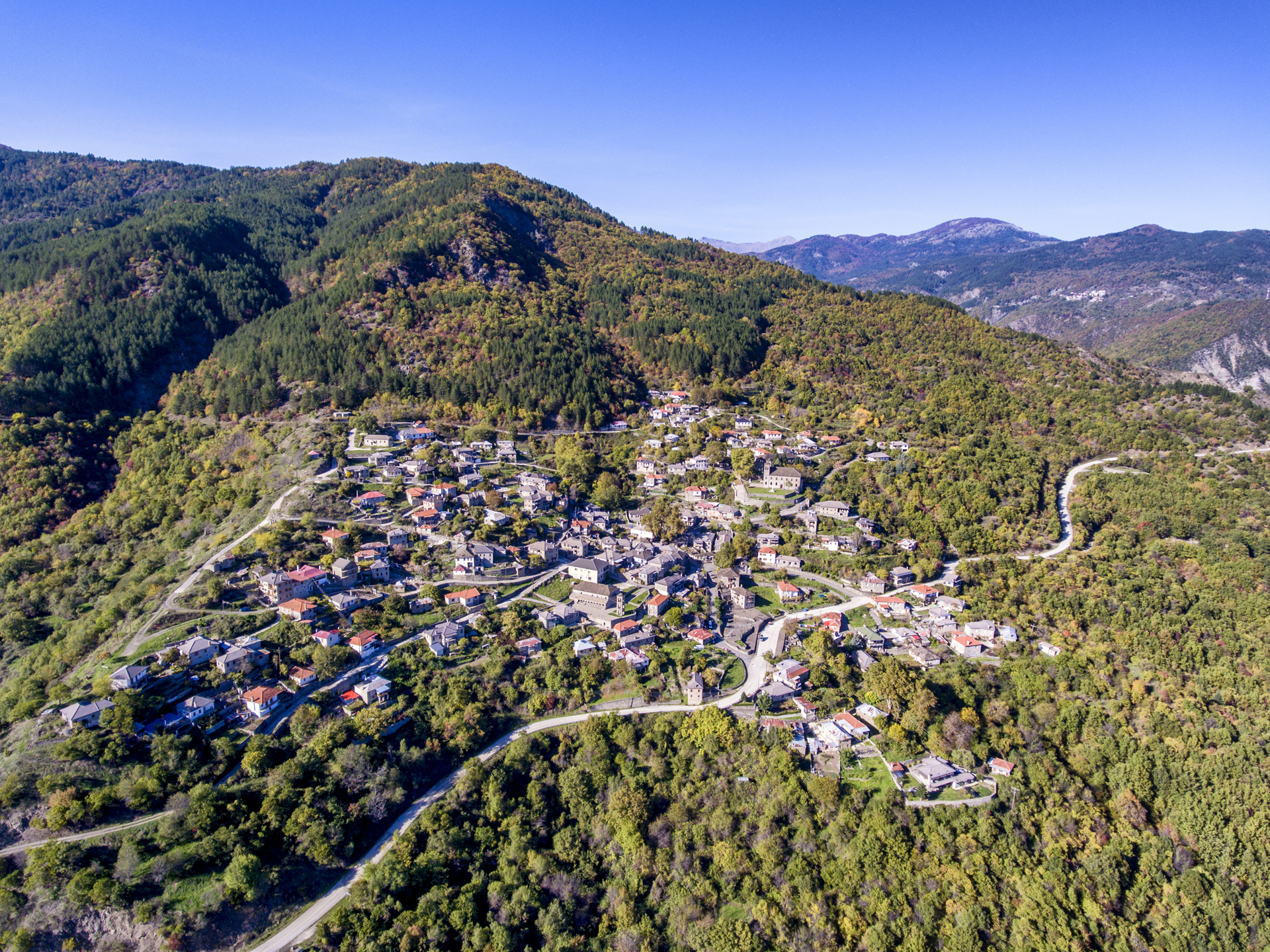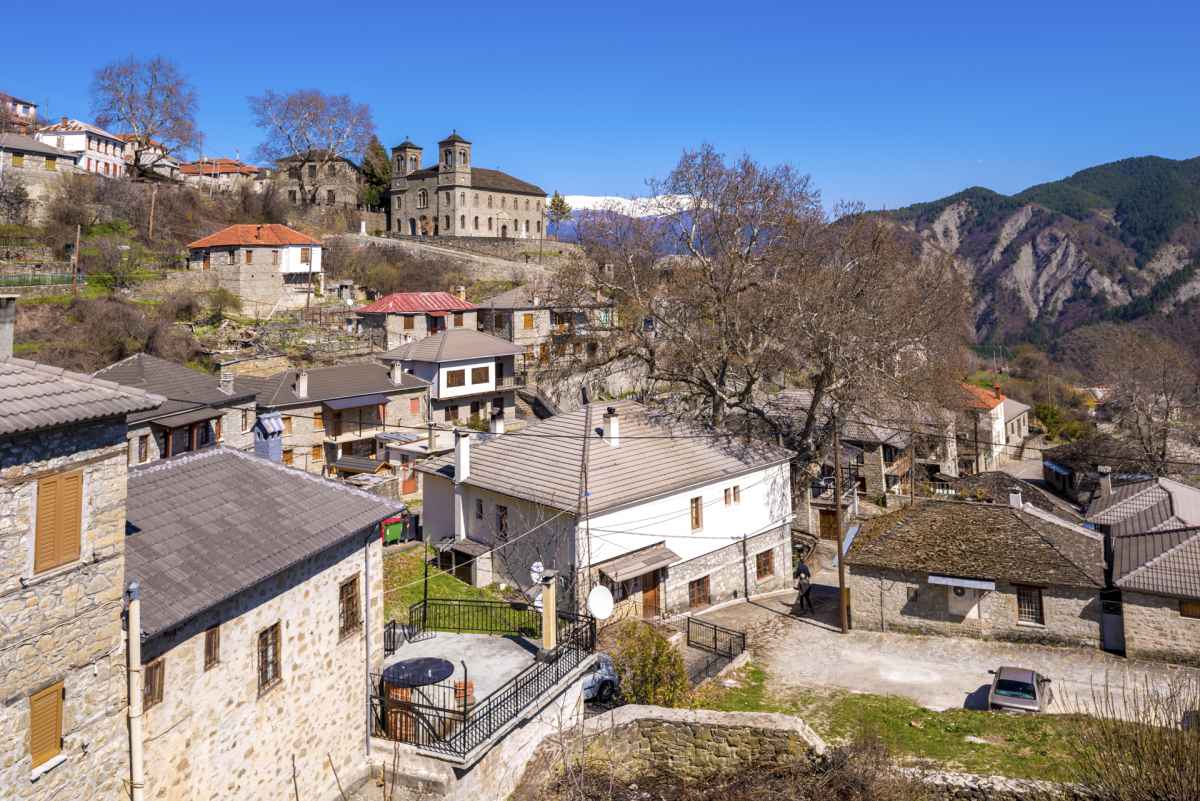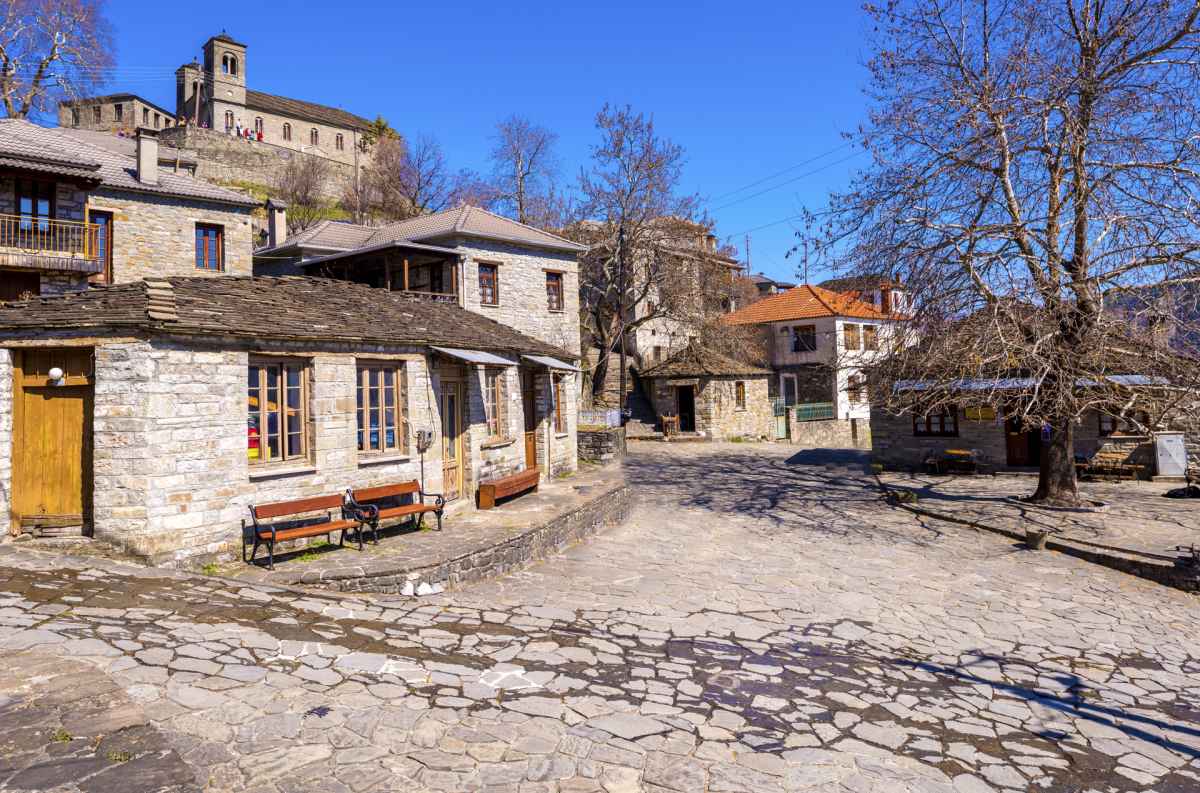Video
1.1 Villages
Pyrsogianni is built at an altitude of 860 meters on the slopes of Mount Steno (1900m) of Grammos mountain range just above the point where Gorgopotamos river joins Sarantaporos river and is 27 km from Konitsa. By the last administrative division was the seat of former Municipality of Mastorochoria. A short distance from the provincial road of Kastorias – Ioannina was one of the main villages in the area. Nowadays, the opening of the main roads and especially the Egnatia Motorway reduced the number of visitors to Mastorochoria and Pyrsogianni, which nevertheless retains elements of the glamor of the past that are reflected in the monuments of traditional architecture, the sett pavings that lead to the neighborhoods with the stone-built mansions and the expertly built churches, all artworks of local craftsmen.
1.2 History
The origins of the creation of the village get lost in the legend. Tradition has it that the village resulted from the union of scattered settlements(neighborhoods) which are located in Zielivos, Panagia, Chalkiades and Agioi Apostoloi. That assumption is supported by the fact that even nowadays at these points are located residues of houses and terraces in farmland – samples of the prior habitation of the village. If we take into consideration that the first old church of St. George in Pyrsogianni was built in 1712 and the church of St. Nicholas was renovated in 1772, it can reasonably be argued that the current Pyrsogianni village was inhabited before 1600-1650. However there are no clear and documented sources to demonstrate the fact of the presence of organized settlement before 1600. The first historical references about Pyrsogianni are found in a reliquary from the monastery of Zerma dated 1780 which refers to the monk Parthenius from Prisogianni village. The residents of Pyrsogianni were initially engaged in agriculture and livestock farming. However, gradually,<<the search for additional resources will lead to a consequent shift in technical activities. So an important part of the population is specialized in building arts and creates a new situation> The craftsmen of stone, however, soon will find places of work outside the confines of the community. Hence as the time passes we see the distinction between permanent residents of the village, the “bakatisious” (native) and the travelers. They will travel throughout the Greek territory and the Balkans, and will reach up to the borders of Afghanistan, Iran, Iraq, coastal Turkey, Egypt, Ethiopia, Sudan, Tanganyika, Congo and America. From 1880-1890 the residents of Pyrsogianni will start moving to the Western Greece and the Peloponnese in particular with the construction of railways during the presidency of Trikoupis on 1910.
1.3 Culture
Pyrsogianni or Prosogianni as it is known in the local dialect is a village predominantly associated with the art of stone craftsmen. Such was their skill that the legend says that Pyrsogianni residents were in conflict with their neighbors in Vourbiani for the primacy of the construction of the world. From Pyrsogianni descended the famous craftsman Ziogas Frontzos who built the bridge of Kato Konitsa in the period of 1870-1871. Ziogas Frontzos performed this task with the help of a workshop of about 80 people while the total cost of the construction of the bridge reached the amount of 120,000 piasters. The engineers who came to check the statics of the bridge raised the question of the integrity of the project and asked the master builder for information on his training to receive the answer “I studied at the Polytechnic Institute of Krapi in Pyrsogianni” in the place where young craftsmen were inducted in the secrets of the art working on the stones of their land. His worthiness was such that in his hometown they say until today: <<Ziogas Frontzos said it, God said it>>
During their migration clutching for whole months the craftsmen were traveling in organized groups (crowds) which were distinguished for their strict hierarchy. At the top and head of the mob was the master builder who had to gather specific abilities and skills to be able to succeed in the difficult task. The remaining crew consisted of two stone craftsmen, two workmen for the inside and two for the outside of building, two tonemasons to assist in the extraction of stone, two craftsmen (apprentices masons ) and two minions (laspopaidia) who undertook ancillary jobs .Of particular interest, however, is the sign language they used among themselves to avoid being noticed by their employers, called koudaritika or mastorika.
1.4 Architecture
Walking in Pyrsogianni you see a harmonious set of cobblestone, stone fountains, doors with slate, wooden frames and lintels, old houses “reflecting the traditional architecture of extraordinary glory and bear the stamp of such geniuses masters” (Municipality Guide 196) Between them are the two main churches, that of St. Nicholas and the one of Saint George as well as the school building and many are the buildings scattered in the village and which reflect the meticulous technique and artistry of old masters who according to the testimony: “The slowly they worked, the better craftsmen they were. They sang and whistled during the creation to forget and not to hurry. They were enjoying their slowness. All their art was a word: slowly““The art and the detail were not missing either from inside the house as evidenced by the exquisite fireplaces with elaborate details carved patiently and with passion on their surface. As said an old master “Look at a stone a volume and think that will become there a Fireplace full of flowers and birds. It wanted love and much patience to give birth to those arched, the branches with leaves and grapes, moons and baklava “ This art, however, will gradually start to decline from 1935 onwards when the entry of new building materials (concrete), will catalyze the hierarchy and the order of the mob, the craftsmen will become autonomous and the art will spoil as they say, “The old had fainted, they could not earn money. There were no more good craftsmen. As to say the source dried up”. In recent years, however, initiatives were developed by the Region of Epirus both for the emergence of this particular cultural capital and for the preservation and continuation of art by establishing ‘School of craftsmen of stone’ and the creation of “Museum of Epirus craftsmen. ” The Museum of Epirus craftsmen is to be accommodated in the stone building of the old school of Pyrsogianni built in 1927 and recently renovated.
1.5 Religion
Central role in the social life of the village have the two churches, that of St. Nicholas and one of Saint George. Both were built on the foundations of older churches, keeping many of the elements of traditional architecture. The church of St. Nicholas is a representative church of northern Greece and belongs to the type called “Macedonian”. This is a three-aisled basilica with the gallery in the west, under a single pitched wooden roof which is covered with stonebars. After that a living room was added to the southern side of the church. (Gallery) at two points of which is inscribed the date 1811. The church was in danger to be demolished in 1955 when Christos Patsisnthe emigrant from Pyrsogianni wanted to make an offer to his birthplace, offering money to rebuild a new church. The offer was accepted by the Community Council, but collided with the reaction of both Kostas Frontzou, president of the company of Epirus Research and Professor Anastasios Orlandos who visited three times Pyrsogianni in order to contribute to the rescue of the temple which was achieved in 1972. That however did not happen with the old church of St. George who dated according to testimonies of local people in 1712, and had excellent frescoes and tall iconostasis with carved decoration dense. The new church of St. George was built according to the standards of the Cathedral of Athens, with voluntary work of craftsmen of the village while the basic cost of the construction was covered by the contributions of people coming from Pyrsogianni from all over the world.
Apart from the two main churches Pyrsogianni is surrounded by a multitude of smaller temples. From the southwest of the village to the north are built the churches of St. Athanasios and St. Nicholas of Chalkias, of the Apostles, Our Lady, Saint Christophoros, the Ascension, of the Holy Trinity, the prophet Elijah, St. Demetrios, St. Haralambos , St. Constantinos and finally on the west side of the village, the chapel of St. Athanasios and St. Minas, on the way of tears as was characteristically said a point of classification of craftsmen.
1.6 Nature
Residents of Pyrsogianni dealt mainly with agriculture and they received the first experience about the treatment and “art” of the stone building stone walls to hold the soil on terraces of the fields and building the first houses intended for permanent installation . Pyrsogianni residents were the first involved in the production of wine and raki. They were naturally favored as the vines were of meridian orientation and the sun bathed them all day. The cultivation was abandoned after the Civil War after being infected with the disease of phylloxera. At the same time the inhabitants were largely utilize the power of the water streams and Sarantaporos river. Until the war of 1940 Pyrsogianni had about ten water mills and dozens of looms in every house. The mills were operating in the winter with water from the nearest streams and in the summer those mills were drying, were working those who were near to Sarantaporos and Vourmpianitiko. The residents were supplied by the the offspring grinding by the mills of the caravans coming daily in summer from Macedonia and Thessaly with muleteers from Ntenitsko (Aetomilitsa).














